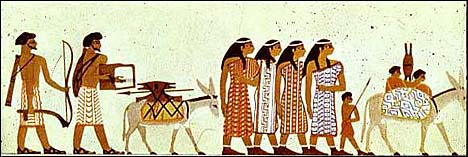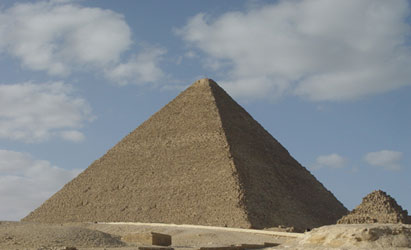 The 11th dynasty marks the beginning of the Middle Kingdom. This dynasty lasted from 2040 to 1640 B.C. The Middle Kingdom was the start of many new things to the Egyptians. Some of these things included trade, arts, and the literature expanded majorly.
The 11th dynasty marks the beginning of the Middle Kingdom. This dynasty lasted from 2040 to 1640 B.C. The Middle Kingdom was the start of many new things to the Egyptians. Some of these things included trade, arts, and the literature expanded majorly.During the Middle Kingdom, there were many kings that ruled the throne. the first known ruler is known to be a man named Nebhetepre Mentuhotep I. Mentuhotep I ruled for about 51 years on the throne. Before Mentuhotep I, Upper and Lower Egypt were ruled by seperate rulers, but then Mentuhotep came around and meshed them into one. He brought great stability to Egypt. "The Middle Kingdom is when the country flourished again as it did in the Old Kingdom". (David, Rosalie.Pg.29 BOOK SOURCE ONE)
Egypt's Middle Kingdom is known as the Golden Age. This is the time where trade, arts, and literature became big and well known. It was also a time where Egypt trained and built up strong armies to defend themselves from their neighbors. During the Middle Kingdom, the kings and pharaoh's were supposed to be grand and very smart. They were to expected to be good to their people and fair to all people also. After the kings or pharaoh's died, they were placed into their tombs where they would then, as they believed, enter the after-life that was filled with wealth or joy or poor-ness and sorrow. It was either a very good or a very bad place.
During the Middle Kingdom, there were many pyramids that were built. Most of the pyramids that are still standing today were built in the old and middle kingdoms. Amenemhet III seemed to be the last powerful pharaoh of the 12th Dynasty. During his reign, he built the first pyramid at Dahshur. The pyramid that he had built was called the Black Pyramid. This pyramid was 272 feet high, 350 feet wide, and had an incline of 57 degrees. The pyramid consists of unburned bricks and clay. Today, the pyramids odd shape stands out in the vast desert.
Since most of the pyramids still standing today were built in the time of the Middle Kingdom, this must mean that they were built very strong and ready for anything to come. When the pyramids were built, they were actually so smooth that they kind of shined. Today, the pyramids are all jagged and messed up because over time, people from the outside cities have come in and stolen some of the stones that they used and used them on another building. And yet they have gotten through all of this and are still standing today.
BOOK SOURCE #1
Rosalie, David. Handbook to Life in Ancient Egypt. New York. Oxford University Press. 1998
BOOK SOURCE #2 ONLINE BOOK!
http://en.wikipedia.org/wiki/Amenemhet_III



